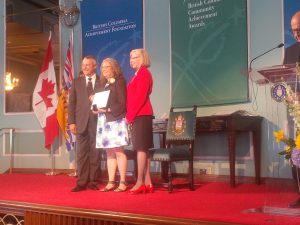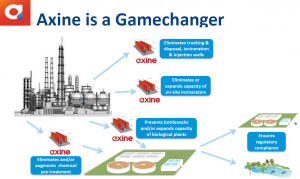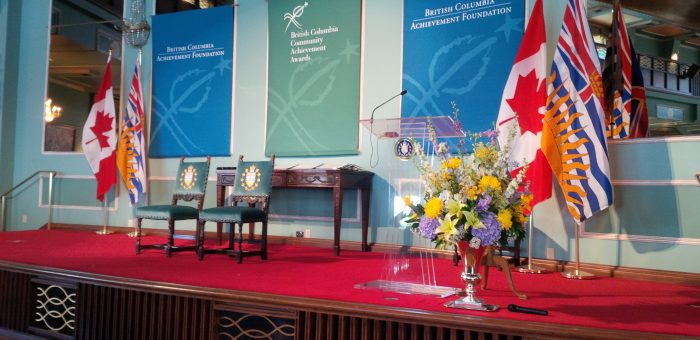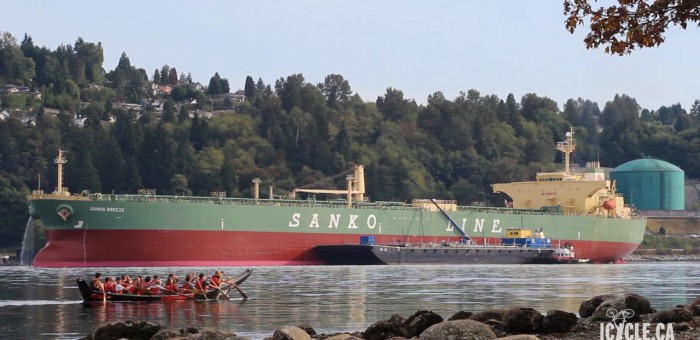Uncategorized
Congratulations to Judy Fainstein & other BC Community Achievement Award Winners
 Today I had the distinct honour of attending the 2016 British Columbia Community Achievement Award ceremony at Government House. The Honourable Judith Guichon, OBC, Lieutenant Governor of British Columbia and the Honourable Peter Fassbender, Minister of Community, Sport and Cultural Development presented 32 British Columbians with distinguished awards “in recognition of their outstanding community contributions“.
Today I had the distinct honour of attending the 2016 British Columbia Community Achievement Award ceremony at Government House. The Honourable Judith Guichon, OBC, Lieutenant Governor of British Columbia and the Honourable Peter Fassbender, Minister of Community, Sport and Cultural Development presented 32 British Columbians with distinguished awards “in recognition of their outstanding community contributions“.
Among the recipients were four Victoria area residents: Haji Charania, Judy Fainstein, Barbara Hulme, Dr. Bernadette Pauly.
It was moving to listen to the citations for each and every one of these incredible British Columbians. Their dedication to the betterment of our communities is an inspiration to us all.
I would like to single out one award winner whose name many of you might recognize. And that is Judy Fainstein, who works in my Constituency Office. As noted in her citation:
 Judy Fainstein has served as a community leader who inspires thousands of youth in British Columbia. Ten years ago, she started Youth for Environmental Stewardship (YesBC) to help young people become environmental leaders. Judy has ensured that the youth she works with take a leading role and this innovative approach has grown the organization into a meaningful and effective environmental education group in BC.
Judy Fainstein has served as a community leader who inspires thousands of youth in British Columbia. Ten years ago, she started Youth for Environmental Stewardship (YesBC) to help young people become environmental leaders. Judy has ensured that the youth she works with take a leading role and this innovative approach has grown the organization into a meaningful and effective environmental education group in BC.
Anyone who has had the pleasure of working with Judy will know how deserving she is of this award. I am truly fortunate to work with Judy and I can assure the residents of Oak Bay-Gordon Head that they are well served by such a dedicated constituency assistant. Below I attach a video of Judy receiving the award.
Congratulations to Judy and congratulations to all winners of the 2016 BC Community Achievement Award.
Celebrating Local Businesses in our Community – Axine Water Technologies Inc.
At times, discussing the challenges facing our environment – especially as it pertains to expansive issues like water pollution – can be overwhelming and discouraging. While these worries are not misplaced, it’s important to talk about solutions and appreciate improvements too. Yes, there are a lot of obstacles ahead of us, but there are also a lot of amazing people in BC working to improve the way we interact with the environment. Clean tech, in particular, is an incredibly inspiring sector.
 In March, before the spring legislative sitting got too busy, I had the distinct honor of visiting a clean tech company that is transforming the way industrial companies treat their wastewater; Axine Water Technologies Inc., based on UBC’s Vancouver campus. Jonathan Rhone, Axine’s Chief Executive Officer, and Jessica Verhagen, the Business Development Executive, walked me through the basics of their electrochemical technology and took me on a tour of their facility. It was a morning that left me marveling at human ingenuity and excited about the potential for progress in reducing the environmental impact of a wide range of industries.
In March, before the spring legislative sitting got too busy, I had the distinct honor of visiting a clean tech company that is transforming the way industrial companies treat their wastewater; Axine Water Technologies Inc., based on UBC’s Vancouver campus. Jonathan Rhone, Axine’s Chief Executive Officer, and Jessica Verhagen, the Business Development Executive, walked me through the basics of their electrochemical technology and took me on a tour of their facility. It was a morning that left me marveling at human ingenuity and excited about the potential for progress in reducing the environmental impact of a wide range of industries.
 Axine has developed an innovative, low cost, chemical-free way for large companies to clean industrial wastewater by removing high concentrations of complex, toxic organics and ammonia. Their system has simultaneously solved a multi-billion dollar headache for companies, and a staggering environmental problem.
Axine has developed an innovative, low cost, chemical-free way for large companies to clean industrial wastewater by removing high concentrations of complex, toxic organics and ammonia. Their system has simultaneously solved a multi-billion dollar headache for companies, and a staggering environmental problem.
Over 10 billion pounds of toxic chemical wastewater are produced annually from chemical, pharmaceutical, petroleum product, and electronic manufacturers in the US. As Jonathan told me in our meeting, that wastewater is becoming more complex, hazardous, difficult, and expensive to treat, posing a growing threat to communities and industry.
“Billions of gallons are so toxic that the only solution is to truck it off-site to be incinerated or pumped into a deep injection well,” he continued. Jessica added that these wastewaters are subject to increasingly stringent regulations, putting pressure on industry to find the lowest cost solutions.
 In a system that requires far less electricity than other electrochemical processes, Axine uses electrolytic cells to create free radicals that react with organic compounds, breaking them down into water, nitrogen, a small amount of carbon dioxide and a high-quality stream of hydrogen. Cells are combined in a modular system that is scalable, versatile, and easily adjusted to accommodate different volumes. It requires no chemicals, produces no sludge and can be used to process a wide range of industrial effluent. Once treated, cleaned water can be reused on site, greatly reducing overall industrial water use.
In a system that requires far less electricity than other electrochemical processes, Axine uses electrolytic cells to create free radicals that react with organic compounds, breaking them down into water, nitrogen, a small amount of carbon dioxide and a high-quality stream of hydrogen. Cells are combined in a modular system that is scalable, versatile, and easily adjusted to accommodate different volumes. It requires no chemicals, produces no sludge and can be used to process a wide range of industrial effluent. Once treated, cleaned water can be reused on site, greatly reducing overall industrial water use.
Their system can be integrated into existing treatment plants to target specific pain points without disrupting operations, Jonathan explained. “Our service model enables customers to access the technology with minimal capital investment and technology risk. We eliminate off-site trucking and disposal, reduce production bottlenecks, increase water reuse and ensure compliance with discharge standards.”
 To see their design in action Goran Sparica, their Senior Vice President of Engineering and Operations, took me on a tour of their lab. Amongst the engineers in lab coats were a series of sealed off compartments with glass windows. Some seemed to have wastewater mid-treatment, with murky water on one side and clear water on the other.
To see their design in action Goran Sparica, their Senior Vice President of Engineering and Operations, took me on a tour of their lab. Amongst the engineers in lab coats were a series of sealed off compartments with glass windows. Some seemed to have wastewater mid-treatment, with murky water on one side and clear water on the other.
“Very toxic,” Goran mentioned as we passed a fridge filled with hazardous waste. Stopping at their field pilot prototype Goran explained how waste-water can be treated in 24 hours, noting that there is nothing like this in the world, “we’re the first to do it.”
Though there is huge interest in their technology from China and India, they are going to finish testing in North America before they further explore that market.
 To help the sector compete globally, however, the clean tech sector in B.C. and Canada will need industry-specific leadership from provincial and federal governments. Axine was among the nearly 200 clean technology companies from across Canada that wrote to the federal government last month, asking for focused budgetary support.
To help the sector compete globally, however, the clean tech sector in B.C. and Canada will need industry-specific leadership from provincial and federal governments. Axine was among the nearly 200 clean technology companies from across Canada that wrote to the federal government last month, asking for focused budgetary support.
The clean tech industry in Canada is composed of more than 800 firms that are environmentally safe, diverse, and employ more than 50,000 people. By 2022 it is expected to be a $50 billion dollar industry. It is Canada’s fastest growing sector.
Back on a smaller scale, Jonathan spoke fondly of the company they are developing. “We have incredible employees. Lots of young people who are so passionate about what they’re doing. We’re having a ton of fun, solving environmental problems on the ground floor and building a more sustainable economy.”
NEB Decision on Kinder Morgan Completely Flawed
Media Statement: May 19, 2016
Andrew Weaver – NEB decision on Kinder Morgan completely flawed
For Immediate Release
Victoria B.C. – In response to the Kinder Morgan announcement by the National Energy Board, Andrew Weaver, Leader of the B.C. Green Party and MLA for Oak Bay-Gordon Head has issued the following statement:
“I’m not surprised by the announcement. Kinder Morgan’s Trans Mountain pipeline, and the approval process it went through, appeared rigged from the start,” says Weaver. “As a participating intervenor I watched as other intervenors withdrew in frustration because they knew their participation was futile.”
“Within the limited constraints of the NEB process I submitted nearly 500 questions to Kinder Morgan which focused primarily on the risk and impact of a potential oil spill, the scientific underpinning of the oceanographic analysis used, and the extent of consultation done by the company. It was clear that the process for this project was not about assessing the best scientific evidence, or whether it was in the interests of British Columbians, but was more of a box-ticking exercise.”
“Fundamentally we don’t have the science or the capacity to deal with a diluted bitumen spill on our coast. The provincial government has voiced its opposition to this project already, and even with all the conditions placed on the project, I don’t see how the province could now turn around and approve it.”
Andrew Weaver was the only BC MLA to seek and receive intervenor status for the NEB Hearing Process. He has been involved in the process since December 2013 when he applied.
-30-
Media Contact
Mat Wright
Press Secretary – Andrew Weaver MLA
Cell: 250 216 3382
Mat.wright@leg.bc.ca
Twitter: @MatVic
Parliament Buildings
Room 027C
Victoria BC V8V 1X4
GMOs: An Update and Potential Ways Forward in BC
Introduction
Since writing our first backgrounder, we have continued to research the issues surrounding genetically modified foods, and the legislative options available in the BC context. The issue of GMOs is broad and complex and is tied to many larger questions including: our relationship to our food, the effects of large-scale conventional agriculture on human and animal health and the environment, population growth, global warming, industry funding of science, technological advance and its associated risks, and our ability to ensure a sustainable and secure food supply for the future. It is important to be cognizant of these broader issues in developing a response to GMOs, to ensure a well informed and holistic response that does not have unforeseen adverse consequences. We must also work within the context of BC, using the tools we have at our disposal to most appropriately and effectively respond to the issues and questions associated with GMOs.
Jurisdiction
Health Canada and the Canadian Food Inspection Agency (CFIA) share responsibility for food policies on health and safety, regulation, and labelling. The BC Liberal government has said that the responsibility for GM products rests solely with the Federal Government (see here and here and here).
However, in 2001, the BC NDP argued that GM labelling is a consumer information matter, which falls under provincial jurisdiction according to the Constitution Act (1867). During second reading of Bill 18 Genetically-Engineered Food Labelling Act, NDP Attorney General Graeme Bowbrick noted “The province has jurisdiction to legislate on a matter of property and civil rights, which is interpreted to include the authority to legislate with regard to consumer protection and consumer information.”
The Food and Agricultural Products Classification Act (2016) gives the Lieutenant Governor in Council the power to make regulations establishing or adopting certification programs, including making regulations respecting the quality standards of food or agricultural products. However, provincial certification will only apply to operators producing and selling their products within BC; those that sell their produce to other provinces will still require federal certification.
In order to fall within BC’s jurisdiction, the impact of any legislation must only be felt within BC and it must not have the effect of prohibiting or controlling the importation of goods into the province. Otherwise, legislation would infringe upon federal jurisdiction over inter-province trade and commerce and therefore be invalid.
Regarding pesticides, a province may prohibit the use of a registered pesticide, or it may add more restrictive conditions on the use of a product than those established under the Pest Control Products Act. This may provide a relevant parallel for the Province’s ability to restrict GM crops that have been approved Federally, or to impose stricter regulations on the use of GM crops within the province.
Effects and Costs of Mandatory Labelling
The BC NDP estimated that mandatory labelling would cost $11.8 million (in today’s dollars; see Note 1 below), which equals 0.1% of total retail food sales in BC. If implemented, mandatory labelling in BC could result in nation-wide labelling by companies, as is happening in the US, where Vermont labelling legislation (going into effect on July 1st, 2016) has led to large companies – including General Mills, Mars and Kellogg – to label their products nationwide.
Potential Ways Forward in the BC Context
Many potential legislative responses to GMOs fall under federal jurisdiction, including the approval and regulation of GM crops for growth and sale in Canada.
In BC, two key responses may be warranted. First, the Ministry of Agriculture could establish a robust tracking and monitoring regime, to track where GM crops are grown in BC, and to pro-actively monitor any actual or potential environmental and agricultural effects of GM crops. The Province does not currently track or monitor GM crops in BC. If any action is warranted, we must first identify and fully understand the scope and impact, if any, of GM crops in our province.
Second, BC should establish an expert panel, made up of independent researchers, to assess the current and potential future impacts of GM agriculture in BC, and to assess the jurisdictional ability, logistics, and costs of implementing mandatory labelling in BC or of increasing the regulation or restriction of GM imports into BC. Independence is important since many studies on GMOs are industry funded, but not all. Some evidence suggests that industry funding systematically biases studies towards favourable outcomes (see Note 2)
So what do you think?
Please continue to share your thoughts on what we should do in BC to address potential or perceived concerns associated with certain GM crops.
Note 1: adjusted 2001 NDP estimate ($9 million) for inflation (BC Ministry of Public Safety and Solicitor General, Regulatory Impact Statement, April, 2001)
Note 2: Healthy People and Communities—Steering Committee, Multi-Sectoral Partnerships Task Group, 2013: Discussion Paper: Public-Private Partnerships with the Food Industry;
Ayevard, P., D. Yach, A.B.Gilmore, and S. Capewell, 2016: Should we welcome food industry funding of public health research? The BMJ, 2016, 353:i2161. doi: 10.1136/bmj.i2161.
Fighting for my Right to do the Job the Official Opposition Leader did not do
Last week I argued that the Leader of the Official Opposition acted in a cowardly fashion in attempting to shut down estimates of the Office of the Premier. I pointed out that it was cowardly for two reasons. First, the fact that the Leader of the Opposition would run away from an opportunity to question the Premier on a diverse array of issues is cowardly. It’s his job to do so. It certainly appears that he is afraid of challenging the Premier face to face.
If the Leader of the Opposition is afraid, that’s one thing. I was not afraid. I would have been willing to take much more than my allocated time on Thursday if extra time was available. I had prepared six longer primary questions (which would spin off into numerous smaller follow ups). I had other secondary questions that I would have loved to raise on a diverse range of topics, from housing through social services through education and so forth. And this brings me to the second reason why I think it’s cowardly.
Just because the Leader of the Opposition no longer wants to ask questions does not give him the right to go against a long standing tradition of organized time allocation and take away my right as well. The people of British Columbia deserve better leadership and better opposition.
Today in the Legislature I rose on a point of order. As you will see from my Point of Order, it is my view that the estimates of the Office of the Premier have not yet concluded due to a procedural error. Once more, the BC NDP asked the Chair to not allow me time.
The text and video of my point of my point of order are reproduced below. At the end, I once more link the Video showing proceedings that closed Premier’s estimates.
UPDATE:
On Tuesday, May 17 the Chair provided a very thoughtful and thorough analysis in ruling against my point of order. I appreciate the work that went into it. I have reproduced the ruling at the end of this post.
Text of my Point of Order
A. Weaver: I rise on a point of order. This is the first time I have been able to rise on this point of order for two reasons. First, on Thursday of last week, I spent much of the day in communications with a variety of offices to determine what transpired with respect to the closing of debate on estimates for the Office of the Premier. I also only received the relevant Hansard clip on Friday.
As I’d mentioned to the Speaker’s office on Thursday last week, my office had coordinated through the Opposition House Leader’s office that I would be speaking to the Premier’s estimates. It was agreed that I would rise early Thursday morning.
Between 6:20 and 6:25 on Wednesday last week, at 292 minutes, 14 seconds of the online Hansard video on May 11, the Premier rose in estimates and stated the following: “With that, Mr. Chair, I rise to report progress and ask leave to sit again.” The Chair then said this: “Hon. members, you heard the motion. All in favour say aye.” The motion carried.
At this point, the committee had risen, and it was very clear that the Chair left his seat. There appeared to be some commotion in the chamber after the passing of this motion. Conversations went back and forth between the Premier and the Leader of the Official Opposition. The Chair remained standing during these conversations. Some notes got passed around. The Clerk also stood to speak with the Premier. The Chair returned to his seat but said nothing while the Clerk was standing and speaking to the Premier.
Eventually the Chair issued a single word. “Premier,” he said. At this point the Premier is audibly heard on Hansard saying: “It’s not mine.” She’s referring to a motion written on a piece of paper that had been passed to her. The Premier then says the following: “By agreement with the opposition, I move that the committee rise and report completion of the resolution and ask leave to sit again.” After this motion passes, the Premier states this: “Are you sure that was legally done?”
In my view, there is a very clear procedural error here. The Chair at no time called the committee back to order while sitting in the chair. Since the earlier motion to rise and report progress had indeed passed, the second motion regarding completion would, in my view, be out of order, as the committee had not been called to order again. It had simply risen.
As such, it is my view that the estimates of the Office of the Premier have not yet concluded. Hon. Chair, I would kindly ask that you consider these comments and consider providing a ruling to this House at a later time. Thank you for your consideration of this very important matter.
M. Farnworth: This is not a procedural point of order. In fact, it would be classed as argument. So, hon. Chair, I respectfully ask that you rule that this is, in fact, not a point of order.
The Chair: Hon. Members, I would take the member’s point of order on advisement. Thank you.
Video of my Point of Order
Video Close of Proceedings on May 11
Point of Order — Chair’s Ruling
The Chair: Before I recognize the Minister of Finance, I have a statement to make.
On Monday, May 16, at the commencement of Committee of Supply, Section B, the member for Oak Bay–Gordon Head rose on a point of order regarding the conclusion of estimates of the Office of the Premier on Wednesday, May 11. I have reviewed the Votes and Proceedings, the Hansard transcript and the video of the proceedings in question.
I acknowledge the question the member raised, but I do not agree that the Committee of Supply was not properly constituted and that, therefore, it could not consider or adopt the motion regarding Vote 10, the 2016-17 estimates for the Office of the Premier.
The proceedings unfolded as follows. An initial motion was moved by the hon. Premier that the committee “rise, report progress and ask leave to sit again.” The Chair put the motion to the committee, and the motion was carried. Normally, the presiding officer would leave the chair and report to the Speaker. However, that did not occur.
Although the presiding officer rose briefly, he was immediately advised that it was the will of the committee to complete consideration of the estimates of the Office of the Premier. At that point, the committee had not formally closed proceedings, nor did the Chair declare that the committee was adjourned. In addition, Office of the Premier staff remained in the Chamber, though it is required that all public servants must depart immediately upon the adjournment of Committee proceedings.
The presiding officer resumed formal proceedings and recognized the Premier, who moved the motion to report completion of the estimates for the Office of the Premier. This motion, and the motion to approve Vote 10, were duly adopted with consent of the committee had altered its original decision to report progress by unanimous agreement of all members duly present and assembled in the chamber at that time.
The Chair did not call the committee back to order, as a recess or adjournment had not been declared. There had simply been a pause in the proceedings in order to confer and clarify with committee members on the status of business. This is not an unusual practice, as presiding officers often will consult informally with members during proceedings to clarify the status of business under consideration or to coordinate matters relating to the management of parliamentary business.
While the video recording captured the informal discussions of members, pursuant to the longstanding Hansard transcript practice they were clearly not part of the formal proceedings. Further, it should be noted that during the entire proceedings, the mace remained in the lowered position, indicating that the House was in committee. In addition, the Speaker had not resumed the chair nor received a report from the committee.
In other words, at all times during the closing of the estimates of the Office of the Premier, the Committee of Supply remained constituted. The presiding officer followed the correct procedure to continue in committee and allow the will of the committee to be respected. It is immaterial that the informal discussion among members to complete the estimates occurred off the record and were recorded on video as interjections.
The Chair heard these discussions and continued to preside in Committee of Supply, rather than reporting to the Speaker. The Premier’s final motions were moved with the unanimous consent of the Members present, were deemed in order and duly passed.
Accordingly, the remainder of the proceedings and the closing of the Estimates of the Office of the Premier on May 11 were in order.
Thank you.
A. Weaver: I just wish to thank you for a very thoughtful and thorough analysis of my point of order, and I do appreciate the work that went into it.










